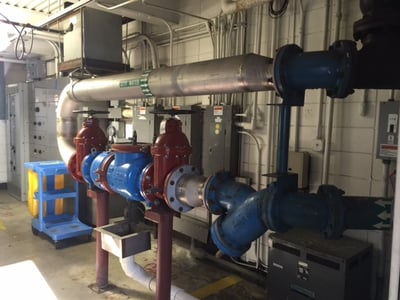Reduced pressure zone (RPZ) backflow assemblies are extremely important. They’re used to keep contaminated water out of the public supply and provide the highest level of protection.
As with any other piece of equipment, it’s best to understand how the RPZ backflow preventer works in order to determine how to install one for ideal use and function. Sadly, many mechanical or plumbing engineers don't spend much time thinking about the backflow preventer during the project design phase and, in many cities across the country, the backflow preventer is installed inside the building.
In response, there is a growing trend across the country where water jurisdictions are requiring the use of an RPZ backflow prevention assembly. In fact, many areas are now requiring the RPZ on all domestic and fire service lines. So, even if you’re in an area where single checks or double checks were once acceptable, that could change, if it hasn’t already.
The Mechanics: How Does It Work?
Backflow preventers work by letting water flow through them in one direction, but prevent water from flowing back through them in a reverse direction, protecting the water supply. A commercial building or industrial plant can use all the water it wants, but once the water has passed through the meter and the backflow preventer, it will not be allowed back into the water supply. An RPZ provides the best level of protection because of its relief valve, which will open up and dump the water as a last resort to prevent contamination.
If you haven’t read our brief post on the differences between DC and RPZ backflow preventers, take a moment to familiarize yourself with their distinction.
To see how the RPZ works in various situations, including illustrations and demonstrations of an RPZ in action, here’s a short video.
Why is the RPZ Important?
The RPZ clearly indicates whether the valve is working properly or if service is needed. If no water is dumping out of the relief valve, the backflow preventer is operating as intended. If the relief valve is dumping water or spitting out water of any amount, maintenance is required. This clear indication of a system issue is why more and more municipalities across the country are requiring the RPZ for both domestic and fire lines.
Where Should the RPZ be Installed?
With the increasing requirements nationwide for RPZ installation, it’s also important to think about where it should be installed. There are two options: inside in a mechanical room or in an RPZ backflow cover.
Because an RPZ is designed to evacuate water, one has to concede the fact that the surrounding area will get wet. For this reason alone, a RPZ should not and cannot be installed inside a structure.  In this picture, the RPZ was installed in a mechanical room. Notice the electrical panels! The plant moved the enclosure outdoors when someone determined this was a dangerous location for the RPZ. Read more about this installation here.
In this picture, the RPZ was installed in a mechanical room. Notice the electrical panels! The plant moved the enclosure outdoors when someone determined this was a dangerous location for the RPZ. Read more about this installation here.
This short video shows an RPZ inside an enclosure in action. The relief valve discharge rate charts for a popular backflow preventer manufacturer indicate an RPZ can discharge an incredible amount of water in a very short amount of time. Here’s an example of how much water dumps from this small-diameter RPZ!
Backflow enclosures were designed with RPZ installation in mind. ASSE 1060 regulations ensure that backflow enclosure manufacturers are designing their products with function and safety in mind. ASSE 1060 testing strictly requires that backflow enclosures provide a drain for when the RPZ inevitably dumps water. For backflow preventers sized 4" and larger, the drain must be able to move 710 gallons per minute.
Backflow enclosures made to these standards also provide easy access for maintenance and repair. The materials used for RPZ enclosures are designed to withstand the elements and are tested for structural strength as well as security.
A backflow enclosure provides excellent protection against theft and vandalism, not only because of its durability of the enclosure, but also because the device is hidden from view. If an RPZ was to discharge water, backflow enclosures provide visible means to detect it. If the RPZ were dumping water inside a building, water would rise until someone entered the mechanical room, or until the damage was so great it surpassed the mechanical room. A heated backflow cover is a perfect place to install the RPZ, protecting the public water supply and protecting the building from water damage.
Safe-T-Cover Enclosures – The Right Decision for RPZ Placement
The RPZ will absolutely protect the public drinking water supply, but if installed in the wrong space, it can potentially cause flood damage to the building. It is important to use best practices when installing an RPZ, and the best place for installation is outside in an RPZ backflow cover.




